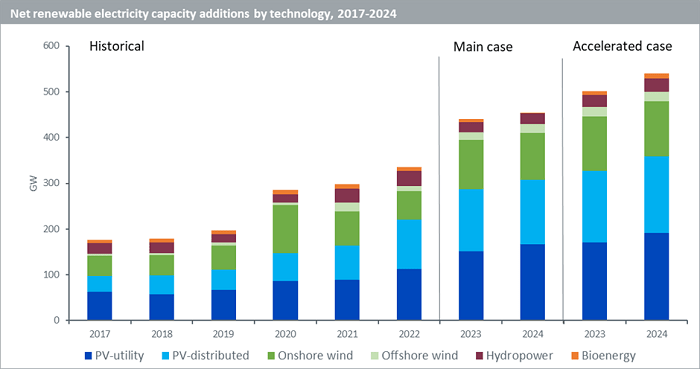In 1887, James Blyth, a professor at Anderson College (now University of Strathclyde), became the first person to generate electricity from wind when he installed a 33ft cloth-sailed wind turbine to light his home in Marykirk, south of Aberdeen in Scotland. Like many inventions in the past, his technology was not wholeheartedly welcomed by the people around him. When offered as a cheap, clean way to light their main street, Marykirk’s villagers declined it fearing ‘the work of the devil’. Nonetheless, Blyth secured a patent and built a second and improved turbine for a nearby asylum which subsequently ran for 30 years1.
Around the same time, the internal combustion engine was being developed for automobiles. And while cars running on fossil fuels proliferated, renewable sources of energy like wind and solar never entered the mainstream. Until now.
A pivotal moment
According to the International Energy Agency2, global renewable capacity is set to rise by 107 gigawatts (GW), the largest absolute increase ever, to more than 440 GW in 2023. To put this in context, this addition in 2023 is more than the entire installed power capacity of Germany and Spain combined. China’s reopening is making a meaningful contribution to onshore wind capacity which is set to rise by 70% this year to 107 GW, an all-time high. Solar photovoltaic (PV), including both large utility-scale and small distributed systems, account for two-thirds of this year’s projected increase in global renewable capacity (see Figure 1). Many countries, particularly those in Europe, have actively sought to wean themselves off fossil fuels in recent months, driving this sudden surge in renewable energy.
Figure 1: Net renewable electricity capacity additions by technology, 2017-2024

Source: IEA, Net renewable electricity capacity additions by technology, 2017-2024, IEA, Paris https://www.iea.org/data-and-statistics/charts/net-renewable-electricity-capacity-additions-by-technology-2017-2024, IEA. Licence: CC BY 4.0. Data as of 01 June 2023. The main case refers to IEA’s central forecast. The accelerated case is where where renewable capacity grows more quickly than in the main case due to policies and other measures that are not currently in the works.
Forecasts are not an indicator of future performance and any investments are subject to risks and uncertainties.
Renewable energy – Europe’s response to the energy crisis
The war in Ukraine has triggered Europe to urgently reduce its dependence on Russian natural gas imports. Renewable energy has been identified as the way to do it. Given recent policy actions by European governments, the International Energy Agency (IEA) has revised its forecasts for renewable energy capacity additions in Europe in 2023 and 2024 upwards by 40% compared to before the war.
Policy and regulatory support are at the core of this endeavour. The IEA states that European countries have done more to ease the permitting process for renewables in the last 18 months than over the entire previous decade. Crucially, the economics of doing so is also starting to make sense. According to the IEA, low-cost wind and solar PV are on course to displace an estimated 230 terawatt-hours (TWh) of expensive fossil fuel generation over the 2021-2023 period, helping to reduce wholesale electricity prices in all European markets. Without these additions, the consumer would have paid 8% higher energy prices in 2022. And, as more capacity gets added, costs are expected to decline even further.
Renewables have a lot going for them
The world has come a long way since James Blyth introduced his wind turbine to his village thirteen decades ago. Today, technological revolutions such as the one brought about by artificial intelligence are wholeheartedly embraced by masses, and the involvement of the devil is seldom suspected. Exciting innovation is also happening and being widely welcomed in the renewable energy space.
One such innovation is floating PV. With land availability limited, floating installations are an emerging technology that can help maintain high growth rates in solar power capacity. According to Wood Mackenzie, the compound annual growth rate for floating solar is expected to rise 15% in the next ten years. 15 countries are forecasted to exceed 500 megawatts (MW) of cumulative floating PV installations by 2031, with China, India, and Indonesia expected to lead the way3.
A final word
Renewables have moved from the margins into the mainstream and are swiftly expected to become a dominant source of energy for the world. And while US, Europe, and China are taking the lead right now, many other countries are starting to get serious about their own energy transition. This means more exciting developments are on their way.
Sources
1 Historytoday.com.
2 International Energy Agency’s Renewable Energy Market Update June 2023. https://www.iea.org/reports/renewable-energy-market-update-june-2023/executive-summary
3 https://www.woodmac.com/press-releases/global-floating-solar-to-top-6gw-threshold-by-2031/

